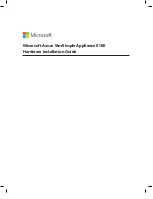
21-6
Cisco IE 3000 Switch Software Configuration Guide
OL-13018-03
Chapter 21 Configuring Resilient Ethernet Protocol
Configuring REP
Spanning Tree Interaction
REP does not interact with STP or with the Flex Link feature, but can coexist with both. A port that
belongs to a segment is removed from spanning tree control and STP BPDUs are not accepted or sent
from segment ports. Therefore, STP cannot run on a segment.
To migrate from an STP ring configuration to REP segment configuration, begin by configuring a single
port in the ring as part of the segment and continue by configuring contiguous ports to minimize the
number of segments. Each segment always contains a blocked port, so multiple segments means multiple
blocked ports and a potential loss of connectivity. When the segment has been configured in both
directions up to the location of the edge ports, you then configure the edge ports.
REP Ports
Ports in REP segments are Failed, Open, or Alternate.
•
A port configured as a regular segment port starts as a failed port.
•
After the neighbor adjacencies are determined, the port transitions to alternate port state, blocking
all VLANs on the interface. Blocked port negotiations occur and when the segment settles, one
blocked port remains in the alternate role and all other ports become open ports.
•
When a failure occurs in a link, all ports move to the failed state. When the alternate port receives
the failure notification, it changes to the open state, forwarding all VLANs.
A regular segment port converted to an edge port, or an edge port converted to a regular segment port,
does not always result in a topology change. If you convert an edge port into a regular segment port,
VLAN load balancing is not implemented unless it has been configured. For VLAN load balancing, you
must configure two edge ports in the segment.
A segment port that is reconfigured as a spanning tree port restarts according the spanning tree
configuration. By default, this is a designated blocking port. If PortFast is configured or if STP is
disabled, the port goes into the forwarding state.
Configuring REP
A segment is a collection of ports connected one to the other in a chain and configured with a segment
ID. To configure REP segments, you configure the REP administrative VLAN (or use the default
VLAN 1) and then add the ports to the segment using interface configuration mode. You should
configure two edge ports in the segment, with one of them the primary edge port and the other by default
the secondary edge port. A segment has only one primary edge port. If you configure two ports in a
segment as the primary edge port, for example ports on different switches, the REP selects one of them
to serve as the segment primary edge port. You can also optionally configure where to send segment
topology change notices (STCNs) and VLAN load balancing.
•
Default REP Configuration, page 21-7
•
REP Configuration Guidelines, page 21-7
•
Configuring the REP Administrative VLAN, page 21-8
•
Configuring REP Interfaces, page 21-9
•
Setting Manual Preemption for VLAN Load Balancing, page 21-12
•
Configuring SNMP Traps for REP, page 21-13
















































